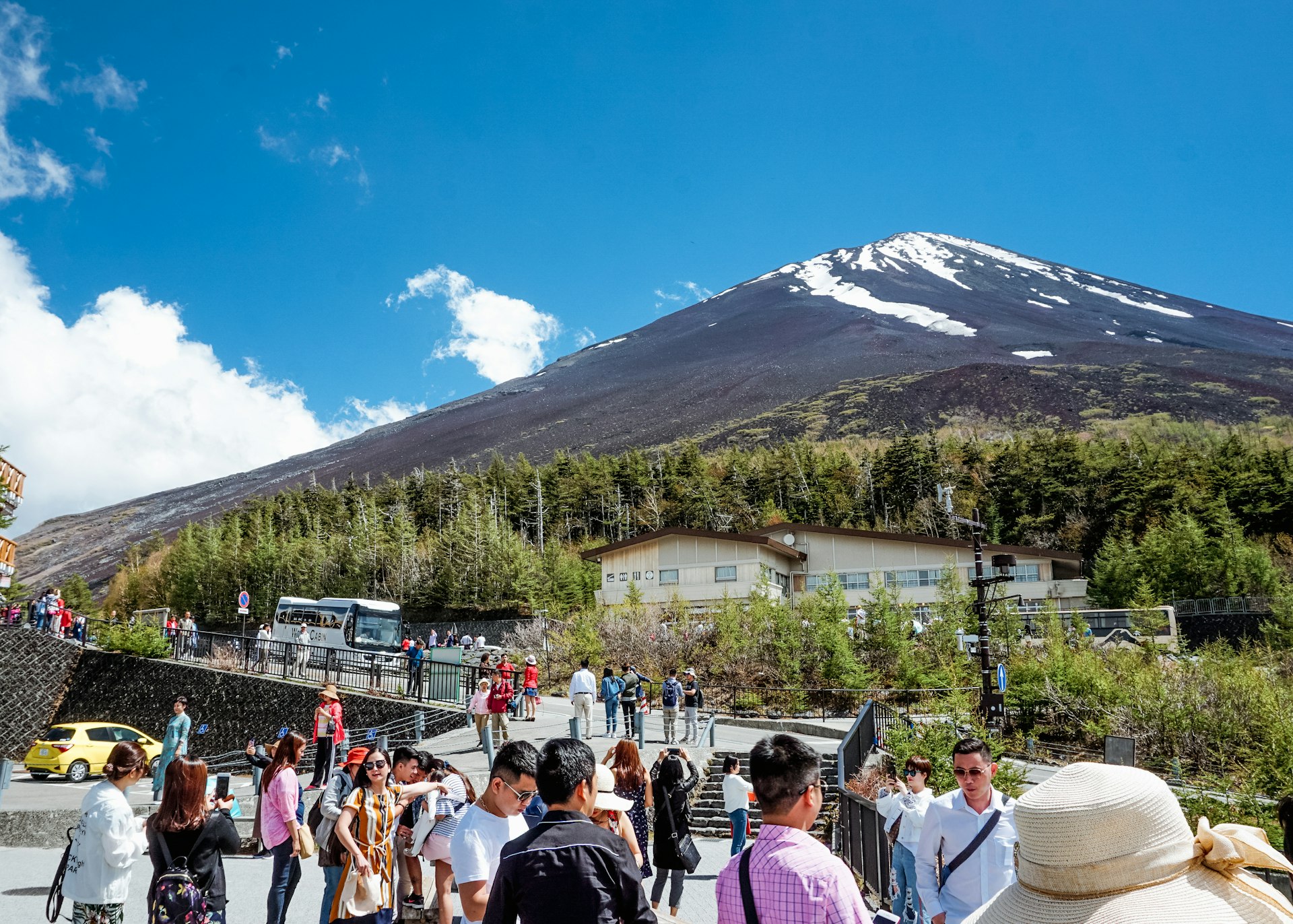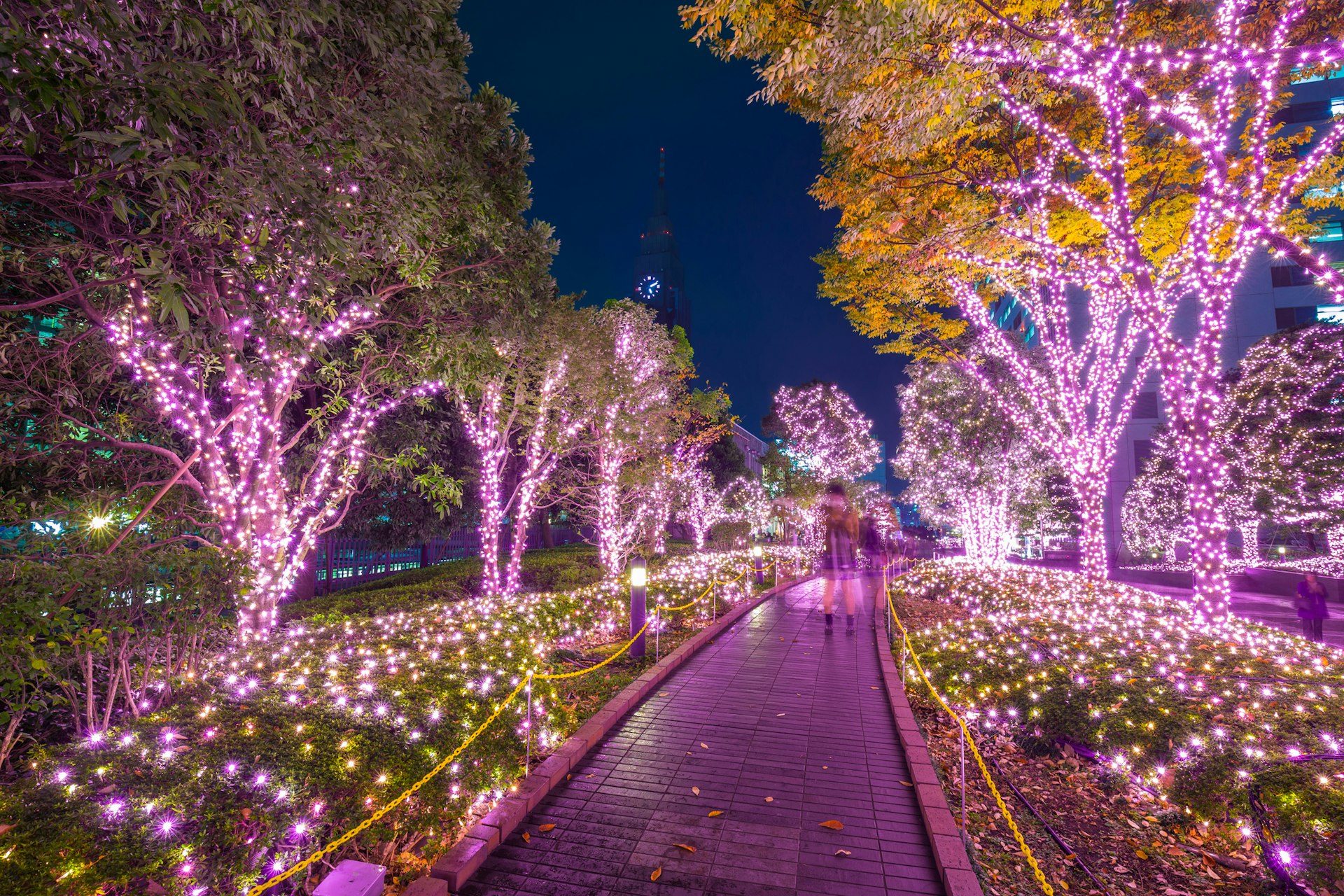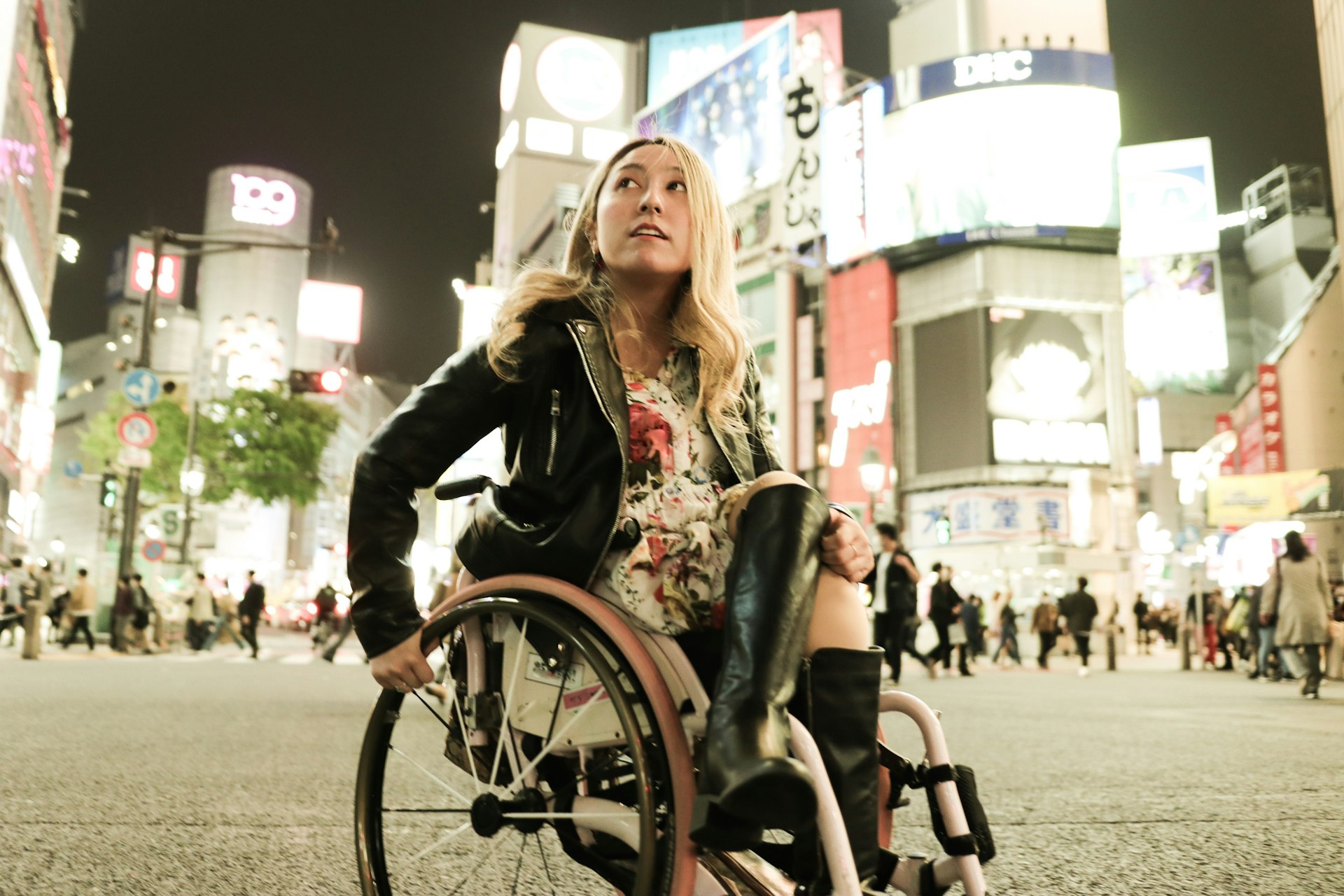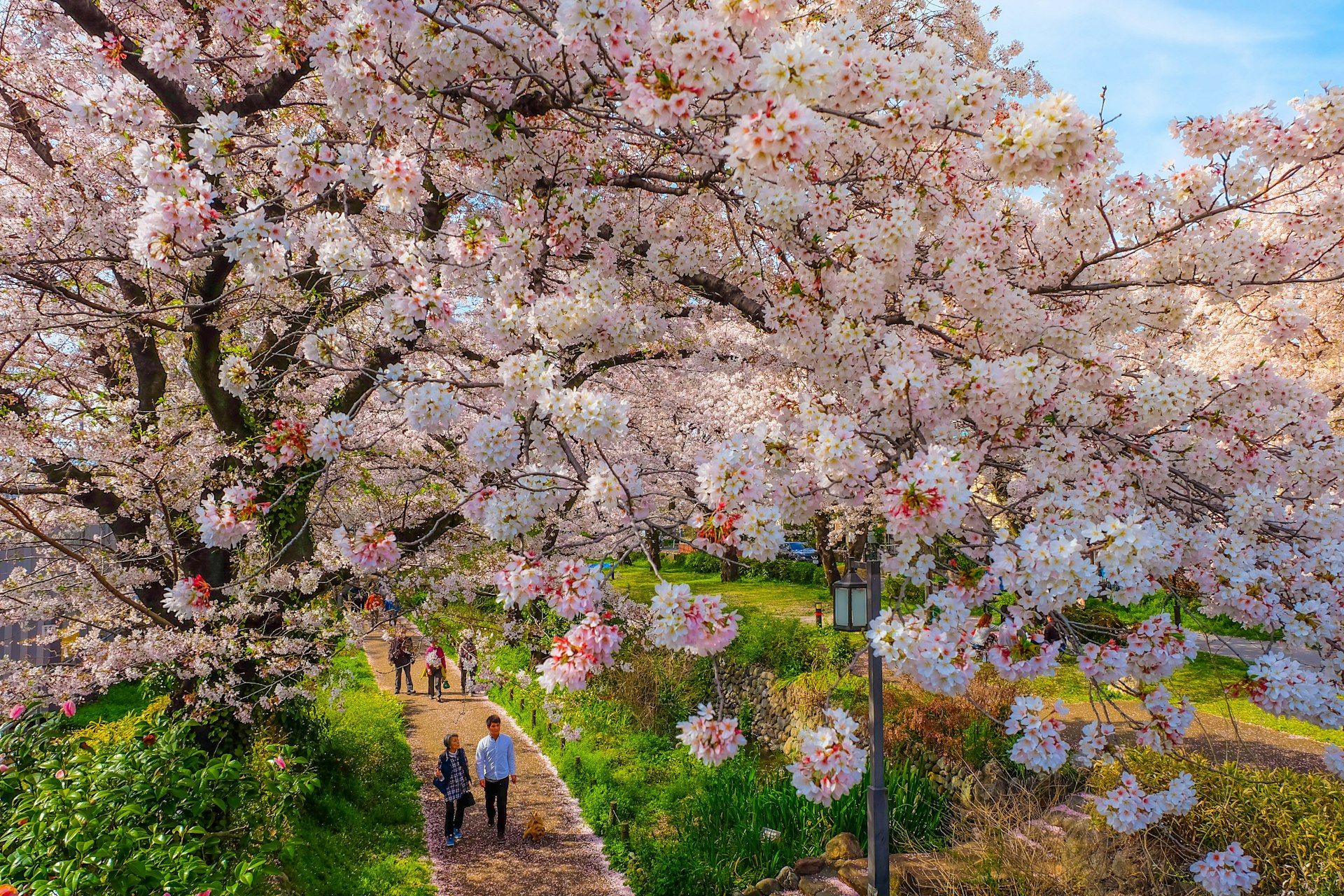Always dynamic, Tokyo shows a new side to its character with each passing season. There’s really no bad time to visit.
Spring and fall bring great weather for sightseeing and seasonal changes in foliage – hanami (flower viewing) in spring and momijigari (leaf-viewing) in autumn – that are followed by locals with giddy enthusiasm.
In summer people gather to watch giant firework displays light up the night sky, and in winter, there are fewer crowds, festive illuminations, and snow-clad Mt Fuji is at its most beautiful.
Whether you’re hoping to catch Japan’s capital at its most lively or simply avoid the tourist crowds, here’s our guide to the best times to visit Tokyo.
There are several high seasons in Tokyo
As Japan’s travel appeal has grown in popularity (it witnessed record-breaking annual tourism figures every year from 2012 to 2019, peaking at 32 million visitors) the high seasons have expanded outwards with it; nowhere has this been more apparent than in the major cities, particularly Tokyo and Kyoto.
While the capital is sprawling enough to accommodate such an influx, Tokyo’s premier attractions are noticeably more thronged for significant stretches of the year as a result. But usually, it’s with good reason.
March to April is cherry blossom season and in May it’s Golden Week
March to May is peak season in Tokyo, with great weather and riots of color in city parks thanks to the famous cherry blossom bloom. Locals and visitors gather for open-air picnics and parties, called hanami, to take in the natural splendor.
March sees the annual Tokyo Marathon and St Patrick’s Day parade roll into town, as well as the celebration of Hina Matsuri (Girls’ Day), where public spaces and homes are decorated with o-hina-sama (princess) dolls in traditional royal dress.
Warmer weather and spring blooms – from floating sakura to tumbling wisteria – make April quite simply a fantastic month to be in Tokyo.
Celebrating the arrival of spring-proper, spirited parties accompany the ritual of hanami (cherry blossom viewing) in parks like Ueno-kōen, Yoyogi-kōen, and Inokashira-kōen – get down early to guarantee a spot on the parks’ extensive lawns.
The month of May is also marked by Ōgon Shūkan (Golden Week), which sees a number of significant holidays take place, giving the city an added buzz. Expect plenty of crowds, jam-packed trains and a spike in accommodation costs.
Weather-wise, May is blissfully warm and sunny, so go for a stroll through Tokyo’s streets and green spaces, or rent a bicycle and explore quieter neighborhoods in between the well-trodden tourist hubs.

Mt Fuji hiking opens in late-July and summer festivals begin
Despite the chance of late-summer rains, energy-sapping humidity in August, and roaring typhoons in fall, a second tourism peak comes in late July and continues more or less unabated until December.
Mt Fuji’s hiking routes are open during July and August, attracting pilgrims and summiters in their stick-wielding droves, while firework-fuelled summer festivals keep people entertained in the city.
When the rainy season passes in mid-July, suddenly it’s summer – the season for lively street fairs and hanabi taikai (fireworks shows).
The grandest of the lot takes place on the last Saturday in July, with an incredible 20,000 pyrotechnic wonders exploding over Asakusa district (beware, crowds can reach one million).
August is the height of Japan’s sticky, hot summer (which locals love to bemoan with the phrase atsui desu ne – “hot, isn’t it?”). The O-Bon national holidays mean attractions popular with students and families will be crowded, while accommodation will likely be pricey.
Asagaya’s Tanabata festival sees Tokyo’s signature shōtengai (shopping arcade), Pearl Centre, decked out with colorful lanterns and papier-mâché decorations (some with cheeky pop culture references).
The twice-annual Comiket (Comic Market) also rolls into town in August, a highlight of the year for major manga fans. It focuses on doujinshi, self-published and fanfic comics.

September to November is best for fall foliage and moon viewing
Clear skies around the autumn equinox in September call for tsukimi (moon-viewing gatherings), another quintessentially Japanese pastime.
Plenty of big events also take place at this time, including the Tokyo Film Festival and extravagant Halloween celebrations in October.
Pleasantly warm days and cool evenings make this an excellent time to be in Tokyo. There are a number of big events too, including Tokyo International Film Festival, screening works from international and Japanese directors, and Halloween, which sees thousands of costumed merry-makers now converge on Shibuya Crossing for one big, chaotic street party.
True to form, late-October also welcomes the Ikebukuro Halloween Street Party, one of the largest cosplay events in Japan.
The temperature cools to agreeable levels as Tokyo moves through the fall, paving the way for the koyo (autumn foliage) phenomenon. O-tori shrines such as Hanazono-jinja hold fairs called Tori-no-ichi where vendors sell kumade – stylized rakes that literally symbolize “raking in the wealth”.
Meanwhile people gather to watch the city’s trees undergo magnificent seasonal transformations during kōyō (autumn foliage season). Rikugi-en, Koishikawa Kōrakuen, and Hama-rikyū Onshi-teien are three favorite local viewing spots.
In November, the city’s parks, gardens, and high streets are painted in fiery hues as deciduous trees – ginkgo, momiji, maple, zelkova, and more – bid their leaves adieu. Some gardens, like Rikugi-en in the north, illuminate the falling leaves after dark.

December to February (plus June and July) are best for avoiding crowds
Tokyo is quiet during the winter period, with the exception of the latter half of December when locals head out to end-of-year work parties and get-togethers.
This is, however, a good time to see the city decked out in dazzling winter lights, and observe religious ceremonies in full swing at temples and shrines during Shōgatsu (the Japanese New Year) at the beginning of January.
Accommodation prices are generally low during this period and crowds are thin. However, it’s worth noting many businesses close over the New Year period.
It’s also quite cold, though frequent clear blue skies mean snow-decked Mt Fuji is particularly beautiful at this time of year.
The height of the rainy season, usually arriving in mid-June to mid-July, is another low season for tourism in Tokyo, but the damp conditions are not great for sightseeing.
Early June is lovely, though by the end of the month tsuyu (the rainy season) sets in. The trade-off is that accommodation prices will drop after the April–May spike.
Should the rain arrive early, visitors can head to the BeerFes Tokyo during the first weekend of June, where over 100 different craft beers from around Japan and the world are on offer at the iconic Yebisu Garden Place.
Other celebrations in June include Sannō Matsuri (held on even-numbered years), a centuries-old festival that involves traditional music performances and takes place over 11 days in mid-June at Hie-jinja.
Keep planning your trip to Tokyo:
Wondering where to stay in Tokyo? We give you a rundown on the best neighborhoods.
Travelling on a budget? Save your yen with tips for visiting Tokyo for less – plus read about the best free things to do when you’re there.
Find out the key things to know before you go.
And why not plan a day trip: here are the best 5 day trips to add to your itinerary.
